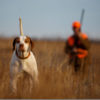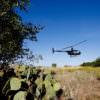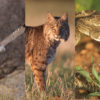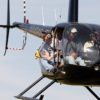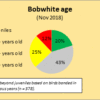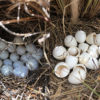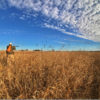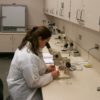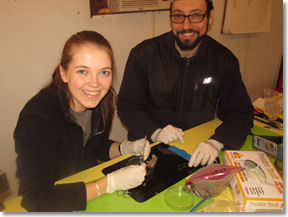
Since 2009 we have studied the incidence and prevalence of the eyeworm (Oxyspirura petrowi) in quails here in West Texas. The initial effort on RPQRR (2009-10) was ramped up with the inception of Operation Idiopathic Decline in 2011 when quail were collected across 35 counties in West Texas and western Oklahoma. The parasite work from 2009-12 was completed in collaboration with Dr. Alan Fedynich at the Caesar Kleberg Wildlife Research Institute. Since 2012, RPQRR has worked with Dr. Ron Kendall at the Wildlife Toxicology Lab (WTL) at Texas Tech University to assess eyeworm impacts on quail. In addition, the WTL has expanded surveillance of cecal worm (Aulonocephalus pennula) presence and impacts on quail in the Rolling Plains (see http://www.tiehh.ttu.edu/rkendall/parasite-research.html for a list of Dr. Kendall’s scientific publications as a jumping-off point into the science to date.)
A recent article by Tom Davis in the March issue of Sporting Classics quoted several of our Directors about our emphasis on parasites (eyeworms and cecal worms). The article produced several ripples throughout the quail hunting community, which has trickled down through various state’s newsletters and news releases.
At their April 30 meeting, the RPQRF Board of Directors adopted the following language as our official stance on our emphasis on our quail parasite research.
What we know
Eyeworms:
- Rolling Plains is the hot spot for infection, typically 50-70% of birds infected (up to 100% in some areas); 8X more prevalent in bobwhite from Rolling Plains vs South Texas Plains;
- Epizootic event in 2013 demonstrated the potential for rapid spread of infection;
- 107 worms found in a single bird (Note: our more recent surveillance counted 188 eyeworms in a bird from RPQRR);
- Feed on tissues and glands within the eyes and nasal sinuses;
- Cause scarring of the cornea as well as damage to other eye tissues; thus providing a mechanism for reduced vision and/or fitness and may explain reports of quail flying into stationary objects
- Several potential intermediate hosts have been identified, including cockroaches, field crickets, and several species of grasshoppers;
- 96% related at the DNA level to the Loa loa, a central African human eyeworm known to cause blindness;
- New molecular techniques are available to allow for on-site, non-lethal sampling of quail to detect eyeworm infection.
Cecal worms:
- Very common throughout the Rolling Plains with 80-90% of birds infected (up to 100% in some areas);
- Over 1,700 worms have been found in a single bird;
- Has been associated with gross pathology, distension of the ceca, and lack of digesta; thus providing a mechanism for reduced fitness, including weight loss;
- 90% related at the DNA level to the Ascarid, or roundworm, of dogs and cats which if left untreated can cause weight loss, malnutrition, and eventual death;
- 13 different species of grasshoppers have been identified as potential intermediate hosts;
- New molecular techniques are available to allow for on-site, non-lethal sampling of quail to detect cecal worm infections.
What we think
- Eyeworms reduce vision and likely predispose quail to predators, flying into objects (e.g., barns, fences, trees), and have difficulty finding food;
- Cecal worms deplete nutrients and may lead to malnutrition, energy loss, reduced breeding potential, and impair ability to evade predators;
- Parasitic infection suppresses the immune system which may leave quail susceptible to secondary infections;
- Because parasites are long-lived, over time an infection may increase until it is eventually fatal, ultimately reducing populations;
- Even low infections may tip the scales against quail in an already challenging environment, e.g. predation by Cooper’s Hawk;
- Implementation of a medicated feed (“Quail Guard”) twice annually (Spring and late Summer) will reduce parasitic infection in wild quail populations;
- Based on the “weight of the evidence” as well as field and laboratory data, we believe that quail are impaired by parasitic infection and their reproduction and survival are reduced.
What we don’t know (at this point)
- How many parasites can a quail harbor before they are impaired? Is it a linear relationship or is it dependent on the bird like people and alcohol consumption?
- What level of infection represents an “action threshold” which would justify treatment?
- How does availability of infected intermediate hosts vary from one year to the next?
- Is there an effect on the immune system of quail? Do high infections leave them more susceptible to other diseases?
- Can the “boom and bust” cycles of quail be reduced by addressing parasite-related concerns?
- What are the consequences of infections of multiple parasite species?
Where we’re headed
- Dr. Kendall’s Wildlife Toxicology Laboratory has developed a medicated feed which we hope earns FDA approval soon and becomes available in 2019;
- WTL is deploying a Mobile Research Laboratory to monitor parasitic infection in quail throughout the Rolling Plains;
- WTL is conducting laboratory studies to evaluate how parasites affect vision;
- WTL plans to evaluate bobwhite immune response to parasitic infection;
- WTL will continue to add to the “weight of the evidence” supporting the hypothesis that parasites are affecting wild quail;
- RPQRR plans to evaluate the efficacy of the medicated feed on survival and breeding success upon approval and availability of the medicated feed;
- RPQRR received about 1,000 quail heads from across West Texas this past Jan-Feb to ascertain the current status/distribution of eyeworms and evaluate field vs. lab techniques for assessing eyeworm infection. RPQRR will produce “heat maps” to identify where prevalence is highest on an annual basis.
Related webisodes:
- How to search for eyeworms in quail https://www.youtube.com/watch?v=xUfqw8dGk5E)
- Addressing the eyeworm threat in quail (https://www.youtube.com/watch?v=tSN0Zi75Cy0&t=60s)
- Examining quail for eyeworms in the field https://www.youtube.com/watch?v=VSfwWONuU0Y)
Websites:


